When Life Hands You Lemons
By Alice Osborne
Yeh, most folks say, “Make lemonade!” But I say, “HEY! Free lemons! ” Well, however you handle your lemons, one thing is for sure, they are so tasty and versatile that being handed some lemons can be a real good thing.
And one thing I wondered for a long time was what in the world is lemon zest and what the heck is a zester (I guess I don’t get out much). So I went searching and found a very succinct answer on WhatsCookingAmerica.com:
For most cooks, tasting is automatic, but when it’s not, the price can be high. Recipes don't always call for the "right" amount of seasoning, cooking times are estimates, and results vary depending on your ingredients, your stove, altitude... and a million other factors. Your palate is the control factor.
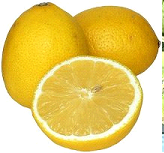 Zest is the rich outermost part of the rind of an orange, lemon, or other citrus fruit, which can be used as flavoring.
Zest is the rich outermost part of the rind of an orange, lemon, or other citrus fruit, which can be used as flavoring.
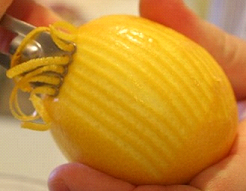 On a lemon, it is the yellow part of the peel on the outside of a lemon. The peel of a citrus fruit contains two top layers; the zest (the outermost part of the rind), and the pith (a white, fibrous membrane directly below the zest which helps to protect the fruit inside). The zest is shiny, brightly colored, and textured; it is the outer surface of the fruit which consumers can directly see.
On a lemon, it is the yellow part of the peel on the outside of a lemon. The peel of a citrus fruit contains two top layers; the zest (the outermost part of the rind), and the pith (a white, fibrous membrane directly below the zest which helps to protect the fruit inside). The zest is shiny, brightly colored, and textured; it is the outer surface of the fruit which consumers can directly see.
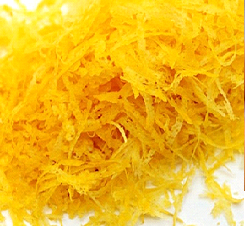 Lemon zest has an intense lemon/citrus flavor with very little bitterness. The bitterness is primarily found in the white part of the lemon (the white pith). The white pith will give your dish a bitter undertaste. Carefully zest your citrus fruits leaving the pith on the fruit.
Lemon zest has an intense lemon/citrus flavor with very little bitterness. The bitterness is primarily found in the white part of the lemon (the white pith). The white pith will give your dish a bitter undertaste. Carefully zest your citrus fruits leaving the pith on the fruit.
Before zesting, scrub the fruit with a sponge and warm, soapy water. Rinse it well and dry it with a paper towel.
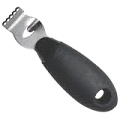 A traditional zester is a tool for removing the zest of a lemon and it makes long, thin strands of zest. A citrus zester allows one to remove the zest (and only the zest). It can make these long threadlike strips because of its tiny cutting holes.
A traditional zester is a tool for removing the zest of a lemon and it makes long, thin strands of zest. A citrus zester allows one to remove the zest (and only the zest). It can make these long threadlike strips because of its tiny cutting holes.
There are so many ways to use citrus zest, especially lemon zest. Just for starters, take a look at these:
Mushroom Ristotto with Lemon Zest
(serves 4)
- 4 cups low-sodium chicken stock
- 1 pound cremini mushrooms, stemmed and quartered
- 1 medium onion, finely diced
- 1 clove garlic, minced
- 1 cup finely grated parmesan cheese
- 2 teaspoons lemon zest
- 1 teaspoon chopped thyme leaves
- 3 tablespoons unsalted butter
- 2 cups Arborio rice
- 1 cup white cooking wine
- salt and pepper
Put the chicken stock in a saucepan and bring it to a low simmer. Prep the onion, garlic and parmesan. Wipe the mushrooms clean with a paper towel. Pull off and discard the stems. Cut the caps into quarters. Before zesting the lemon, scrub with a brush and a little soap and water. Rinse it well and dry it. Remove the zest (yellow part only) with a Microplane grater or zester. Pull the thyme leaves off the stem and chop them.
Melt 1 tablespoon of the butter in a large saucepan over medium-high heat. When the foam subsides, add the mushrooms and thyme and stir. Season the mushrooms lightly with salt and pepper. Cook, stirring often, until the mushrooms are brown, 8-10 minutes. Remove the mushrooms to a plate.
In the same pan heat the remaining 2 tablespoons of butter over medium-high heat. When the foam subsides, add the onions and stir. Cook, stirring often, until the onions are translucent, 8-10 minutes. Add the rice and cook, stirring often, until the edges become translucent, 3-5 minutes. Add the wine and cook until the wine evaporates, 2-4 minutes. Add 1 cup of the stock. Cook, stirring occasionally to prevent the rice from sticking, until almost all the liquid evaporates. Stir in another 1/2 cup stock each time the liquid is absorbed. Stir in the sauteed mushrooms after about 8 minutes. Continue adding stock until the rice is tender but firm in the center, 10-15 minutes total.
Stir in the lemon zest and parmesan and stir to combine. Add more salt and pepper to taste.
Lemon Poppy Seed Muffins
(makes 12 muffins)
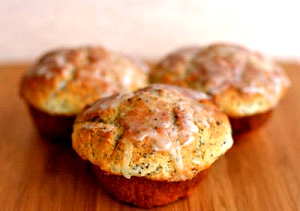
- 3 cups of all-purpose flour
- 1 Tbsp baking powder (aluminum-free, such as Rumfords)
- 1/2 teaspoon baking soda
- 1/2 teaspoon salt
- 3 Tbsp poppy seeds
- 10 Tbsp unsalted butter (1 1/4 stick), softened
- 1 cup sugar
- 2 large eggs
- 1 1/2 cup plain yogurt
- 1 to 2 Tbsp lemon zest
- Glaze
- 2 Tbsp fresh lemon juice
- 1 cup confectioner's sugar (powdered sugar)
Adjust the oven rack to the middle-lower part of the oven. Preheat oven to 375 F. Whisk together the flour, baking powder, baking soda, poppy seeds, and salt and set aside. In a large mixing bowl, cream butter and sugar together, beating until fluffy (about 2 minutes with an electric mixer). Add eggs one at a time, beating until incorporated after each one. Beat in the lemon zest.
Beat in one third of the dry ingredients until just incorporated. Beat in one third of the yogurt. Beat in a third more of the dry ingredients. Beat in a second third of the yogurt. Beat in the remaining dry ingredients and then the remaining yogurt. Again be careful to beat until just incorporated. Do not over beat.
Use a standard 12-muffin muffin pan. Coat each muffin cup lightly with olive oil, grapeseed oil, or a little melted butter using a pastry brush. Distribute the muffin dough equally among the cups. Bake until muffins are golden brown, about 25 to 30 minutes. Test with a long toothpick (we use a thin bamboo skewer) to make sure the center of the muffins are done. Set muffin pan on wire rack to cool. After 5 minutes, remove muffins from pan.
While the muffins are cooling, in a bowl, whisk together the powdered sugar and lemon juice for the glaze. Add more lemon juice if necessary. While the muffins are still a bit warm, use a pastry brush to brush the glaze over each muffin. The muffins will absorb some of the glaze, so you add more glaze to each muffin if you like.
Broccoli Fettucine with Lemon Zest
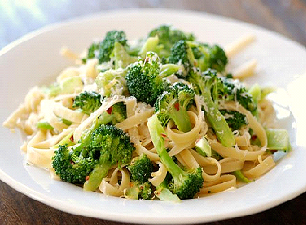
- 1/2 pound of fettuccine
- 1 pound of broccoli
- Extra virgin, cold pressed olive oil
- 2 tsp red pepper flakes
- 1 Tbsp lemon zest
- 1/2 to 3/4 C freshly grated Parmesan cheese (or to taste; for me, the more cheese, the better)
Cut the broccoli into florets and boil the pasta until al dente. Sautee broccoli in olive oil until barely tender; add the noodles to the pan along with a little pasta water, and finish it all with a drizzle of olive oil, a pinch of red pepper flakes, a little lemon zest and a sprinkling of parmesan.
More uses for Lemons
- Lemon zest can be successfully added to any waffle, muffin, shortbread, recipes; you can even add it to the piecrust for lemon meringue pie - what a wonderful surprise this is.
- A lemon at room temperature will yield more juice.
- Before juicing, press down firmly and roll the lemon on the kitchen counter to break up the pulp before juicing.
- If the lemon is very cold, you can microwave it for a few seconds before squeezing.
- Freeze the juice in ice cube trays, when frozen save in a plastic bag.
- Grate lemon zest; seal tightly in plastic bag & freeze.
- Put lemon wedges inside the cavity of a whole chicken.
- Tenderize meat by marinating it in lemon juice.
- Squeeze lemon on vegetables while steaming, to keep the colors bright.
- Add it to rice while cooking to make the rice fluffier.

Contribute to the Cook'n Club!
DVO would love to publish your article, prose, photography and art as well as your cooking, kitchen and nutrition tips, tricks and secrets. Visit the Newsletter Submission / Win Win for All section in our Forum for more information and details.

